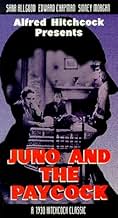ÉVALUATION IMDb
4,6/10
2,6 k
MA NOTE
Pendant la guerre civile irlandaise en 1922, une famille reçoit un gros héritage. Ils commencent à mener une vie riche, oubliant quelles sont les valeurs les plus importantes.Pendant la guerre civile irlandaise en 1922, une famille reçoit un gros héritage. Ils commencent à mener une vie riche, oubliant quelles sont les valeurs les plus importantes.Pendant la guerre civile irlandaise en 1922, une famille reçoit un gros héritage. Ils commencent à mener une vie riche, oubliant quelles sont les valeurs les plus importantes.
Maire O'Neill
- Maisie Madigan
- (as Maire O'Neil)
Dennis Wyndham
- The Mobiliser
- (as Denis Wyndham)
Fred Schwartz
- Mr. Kelly
- (as Fred Schwarz)
Donald Calthrop
- Needle Nugent
- (uncredited)
George Spence
- Man in Crowd
- (uncredited)
Histoire
Le saviez-vous
- AnecdotesHitchcock's first film shot entirely with sound throughout. His previous film Blackmail was shot silently and later parts were re-filmed with sound, post dubbing being a non-existent technology yet, and released as a "part-talkie".
- GaffesWhen Maisie Madigan is drunk at the Boyle's house, she strolls across the kitchen and Mrs. Boyel's arms are by her side, but in the next shot, Mrs. Boyle's arms are crossed.
- Citations
Captain Boyle: Well, isn't all religions curious? If they weren't, how would you get anyone to believe in them?
- ConnexionsFeatured in Paul Merton Looks at Alfred Hitchcock (2009)
Commentaire en vedette
Having been a Hitchcock fan for forty years I have not been able to see this until now, thanks to a very cheap and poor quality DVD.
This straightforward fill of Sean O'Casey's play turns out to be a powerful piece of admittedly primitive early film-making. This is from a time when sound editing was impossible - scenes had to be taken in long takes with four cameras and cut ins added in - very much like studio TV.
I am shocked that one reviewer refers to bad photography with heads cut off. That's the bad transfer on the disc which cuts quite a lot of the image, often cutting of heads. If we could see a good print this would be powerful stuff with, surprisingly, a lot of very strong Hitchcock moments - including a ma in atrench coat waiting in the street - to execute JOhnny who was betrayed his republican group. It's also an extraordinarily authentic picture of an intensely catholic world. Ireland is still suffering from internal fighting but the is celebrating independence - but at the same time these people suffer from extreme judgemental attitudes. The rejection of the pregnant daughter by her previous boyfriend is simple and chilling.
We desperately need restorations of Hitchcock's pre 1934 films. The silents are excellent when you see them pristine. The copies in circulation are only hints of what they are really like. In its way a key work in Hitchcock's oeuvre. He may have dismissed it in the TRuffaut interviews, but take that with a pinch of salt. He avoids any mention of Fritz Lang influence too - and yet if you see Spione, M, or the Mabuse films you see how much he owed to Lang.
This straightforward fill of Sean O'Casey's play turns out to be a powerful piece of admittedly primitive early film-making. This is from a time when sound editing was impossible - scenes had to be taken in long takes with four cameras and cut ins added in - very much like studio TV.
I am shocked that one reviewer refers to bad photography with heads cut off. That's the bad transfer on the disc which cuts quite a lot of the image, often cutting of heads. If we could see a good print this would be powerful stuff with, surprisingly, a lot of very strong Hitchcock moments - including a ma in atrench coat waiting in the street - to execute JOhnny who was betrayed his republican group. It's also an extraordinarily authentic picture of an intensely catholic world. Ireland is still suffering from internal fighting but the is celebrating independence - but at the same time these people suffer from extreme judgemental attitudes. The rejection of the pregnant daughter by her previous boyfriend is simple and chilling.
We desperately need restorations of Hitchcock's pre 1934 films. The silents are excellent when you see them pristine. The copies in circulation are only hints of what they are really like. In its way a key work in Hitchcock's oeuvre. He may have dismissed it in the TRuffaut interviews, but take that with a pinch of salt. He avoids any mention of Fritz Lang influence too - and yet if you see Spione, M, or the Mabuse films you see how much he owed to Lang.
- ajbakeresq
- 16 févr. 2007
- Lien permanent
Meilleurs choix
Connectez-vous pour évaluer et surveiller les recommandations personnalisées
Détails
- Date de sortie
- Pays d’origine
- Langues
- Aussi connu sous le nom de
- The Shame of Mary Boyle
- Lieux de tournage
- société de production
- Consultez plus de crédits d'entreprise sur IMDbPro
- Durée1 heure 25 minutes
- Couleur
- Rapport de forme
- 1.20 : 1
Contribuer à cette page
Suggérer une modification ou ajouter du contenu manquant

Lacune principale
By what name was Juno and the Paycock (1929) officially released in Canada in English?
Répondre




























